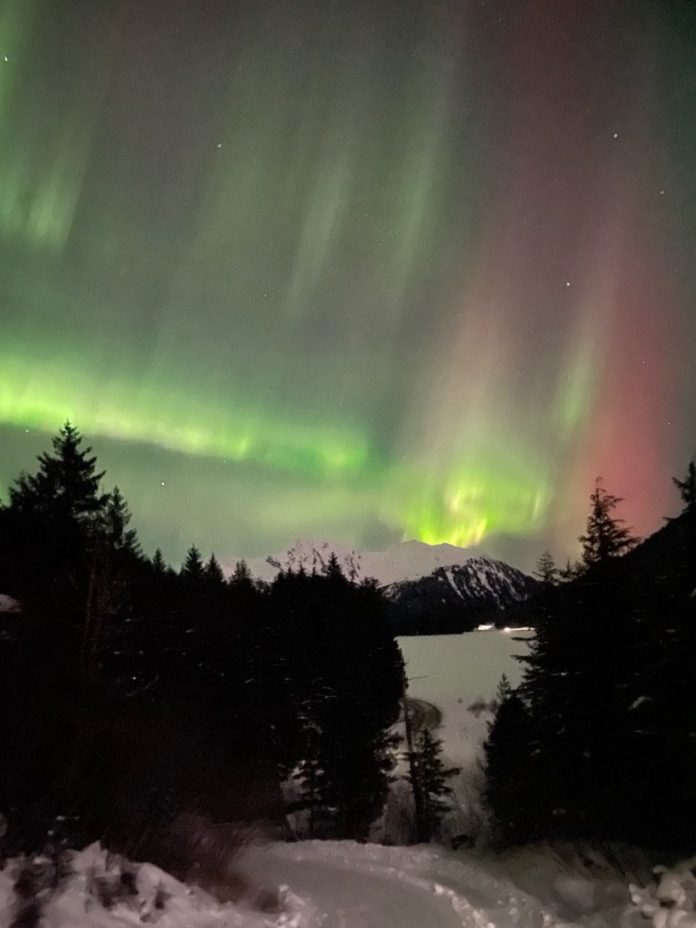
The Cremation of Sam McGee
— Robert Service
There are strange things done in the midnight sun
By the men who moil for gold;
The Arctic trails have their secret tales
That would make your blood run cold;
The Northern Lights have seen queer sights,
But the queerest they ever did see
Was that night on the marge of Lake Lebarge
I cremated Sam McGee….
Robert Service was not on the “marge” of Lake Eyak on the night of Feb. 26, 2013, but he would agree that “the Northern Lights have seen queer sights” during a spectacular multi-hued display that had Cordovans donning coats and boots over their pajamas to race out and witness the most phenomenal auroral show likely ever seen here.
It was a cold clear night, and accustomed to Northern Lights that don’t last long, my wife Sue and I sped down to the ferry dock thusly attired to avoid the distraction of nearby city lights. One did not have to stand outside her Subaru very long to understand why Sam McGee, who came from Tennessee to search for Klondike gold, was always cold and was glad to be poetically cremated and finally warm.
Between ooh’s, aah’s, and shivers, the spectacle in the sky did inspire questions. For example, what causes the different colors, which in this case included red, purple, orange, yellow, and green?
The light show is caused by electrically charged particles from space that originated from the sun entering the Earth’s upper atmosphere at very high speed. The color varies depending upon what elevation the strike occurred.
Oxygen is the most common atom high in the ionosphere, and collisions there create a rare red aurora. The strong yellow to green light is produced by collisions with oxygen at lower altitudes, between 100 to 300 km. Around 100 km, nitrogen molecules produce a red light that often seems to show on lower fringes of aural curtains.
The displays change shape with breathtaking speed. Scientists are still studying why this happens. It appears to depend on where in the earth’s magnetic field the collisions occur.
Is there such a thing as Southern Lights? Yes indeed, due to a similar magnetic field near the South Pole. The displays there are called “Aurora Australis.”
Where did the name Aurora Borealis come from?
Credit astronomer Galileo Galilei, who in 1616 used this name to describe the phenomenon using Aurora, the mythical Roman goddess of dawn, and Boreas, the Greek name for wind from the north.
How long have the Aurora Borealis been observed?
Cave paintings in France dating back 30,000 years recorded the phenomenon. In superstitious times the lights had been thought to be the precursor to conflict or disaster.
The oldest known written record of sighting “northern light” was recently discovered by a team of scientists in an ancient Chinese text titled “Bamboo Annals.” They believe this happened in the 10th century B.C. or about 300 years before the next chronicle of the celestial display by the Assyrians.
An oft debated question: “Do northern lights make sound?” For years scientists denied this claim. However, in 2016 a Finnish study confirmed that Aurora Borealis does produce a sound that can be heard. In fact, Professor Emeritus Unto K. Laine of Aalto University has made recordings of auroral sounds that show the commonness of the phenomenon. It is described as a faint hissing or crackling.
For Cordovans on late Sunday night, Feb. 26th, 2013, the only sounds were that of awe, to which Robert Service, “the Bard of the Yukon,” could poetically relate.
I wonder if Sam McGee ever tried watching them in his pajamas and boots.





